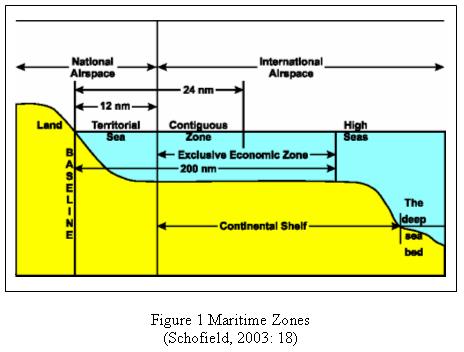The traditional modes of acquiring territory of a state are:
(a) discovery, (b) occupation, (c) prescription, (d) cession, (e) annexation, (f) conquest, (g) accretion and (h) avulsion.
Discovery is the oldest method of acquiring title to territory. However, discovery alone would not suffice to establish legal title. It is necessary that the discovered area must be physically occupied. Related to title by discovery is the
hinterland doctrine or the
principle of continuity. If a state has made a settlement, it has a right to assume sovereignty over all adjacent vacant territory, which is necessary to the integrity and security of the settlement.
Occupation is the intentional acquisition by a state over a territory which at the time of claim not under the sovereignty of any state. There are two requirements: (1) the territory subject of claim must not be under the sovereignty of any state (
terra nullius); and (2) the state must have effectively occupied the territory, that is, the state claiming the territory must have exercised immediate occupation (
corpus occupandi) on the territory after it displayed its intention to occupy (
animus occupandi).
There are two elements of effective occupation. One is the intention and will to act as sovereign (
animus), and two is the peaceful and continuous display of state authority (
factum). The intention can be displayed from the simple fact of publishing notices of sovereignty in various state journals or issuing laws on territorial assertions. The display of state authority must be peaceful and continuous. Mere protests from rival claimant states do not lose the peaceful character of the display of state authority. However, consistent protests over a long period of time if not rebutted by the claimant state may disturb the peaceful character of the display of state authority. The continuous display of state authority encompasses two ideas: (1) that the display of authority is ongoing;
and (2) the display of state authority must exist up to the "critical date". The critical date in a territorial dispute is the date on which the location of territorial sovereignty is decisive. Normally it is the date of the origin of the dispute. The state which can present an effective title in the period immediately preceding the critical date has the superior claim.
Prescription means continued occupation over a long period of time by one state of territory actually and originally belonging to another state. There are four requirements of prescription: (1) the possession must be exercised in the form of actual exercise of sovereign authority; (2) the possession must be peaceful and uninterrupted; (3) the possession must be public; and (4) the possession must be for a long period of time. The peaceful and continuous display is also an essential element although as compared to occupation, prescription requires a stricter proof and longer period of the display of authority. Moreover, any protest or objection by the losing state destroys the peaceful display of authority of the claiming state.
Cession is the transfer of territory usually by treaty from one state to another. Concomitant of transfer of territory is the transfer of sovereignty from the owner state to another state. And since cession is a bilateral transaction, the parties involved are states. Cession may also be in the form of exchange of territory or in the form gift or donation or devise.
Conquest is acquiring territory by the use of force. The practice before was after conquest, the conqueror annexed the conquered territory to his state. Thus, conquest first takes place followed by
annexation. But with the establishment of the United Nations, conquest is no longer acceptable in the international community.
A state may also increase or decrease its territory through accression and avulsion.
Accression is the attainment of sovereignty over new land due to slow movement of natural forces. Example of this is the gradual movement of a river bed. On the other hand, if the natural forces happened suddenly, like creation of an island in territorial waters due to volcanic eruption, it is referred as
avulsion.
Related cases:
- The Island of Palmas (Miangas) Arbitration, The Netherlands vs. United States
- Kalayaan Group of Islands
- Western Sahara Case
- Eastern Greenland Case
- Clipperton Island Case
- Pulau Ligitan and Pulao Sipadan Case, Indonesia vs. Malaysia
- Pedra Branca and Pulau Bato Puteh, Malaysia vs. Singapore
Useful links:





















